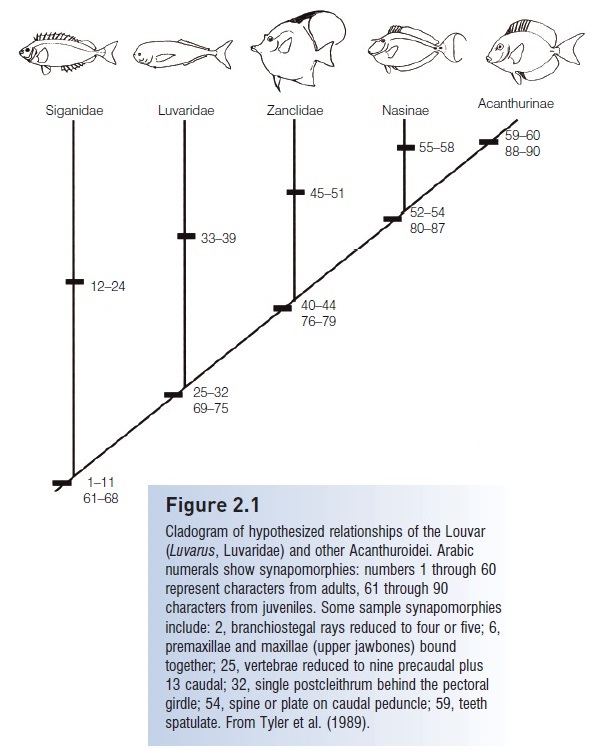Chapter: The Diversity of Fishes: Biology, Evolution, and Ecology: Teleosts at last II:spiny-rayed fishes
Suborder Acanthuroidei
Suborder Acanthuroidei
This suborder contains, with one exception, a group of medium-sized, compressed fishes with small mouths that usually form shoals over coral reefs or in nearby habitats. The ephippid spadefishes (e.g., Chaetodipterus, western Atlantic) and batfishes (e.g., Platax, Indo-Pacific) are conspicuous inhabitants of drop-offs and passes around reefs,although young spadefishes also frequent sandy beaches along the Atlantic coast of the USA. Juveniles of both genera look and act remarkably like floating leaves, and juvenile batfishes are popular in the aquarium trade. Their growth to large size however makes them less desirable pets, prompting aquarists to release Indo-Pacific batfishes into south Florida (Semmens et al. 2004). The scatophagid scats bear a slight resemblance to serrasalmine piranhas,but as their name implies, their feeding habits tend more toward feces and detritus than to live prey. They are inhabitants of estuaries and the lower portions of rivers in the Indo-Pacific, where they are reputed to hang out near sewage outfalls. Rabbitfishes (Siganidae) are reef,grass bed, and estuarine herbivores with a unique pelvic formula of I, 3, I, reflecting the hard spine at either edgeof the fin. Rabbitfishes are in fact very spiny fishes, their first dorsal spine projecting forward rather than upward,and many of the spines possessing a painful toxin (the forward projecting spine frequently impales the uninitiatedfisher). Although most rabbitfishes are counter shaded species that shoal in seagrass and mangrove areas, reef dwelling species such as the Fox-face, Lo vulpinus, convergein coloration and habitat with butterflyfishes and even form apparently monogamous pairs, as happens inseveral butterfl yfishes. The monotypic louvar, Luvarusimperialis (Luvaridae), is a pelagic derivative of the suborder(see Fig. 2.1). It is a large (to 1.8 m, 140 kg), nonshoalingfish with extremely high fecundity, a large female containing nearly 50 million eggs. Louvars converge with the pelagic scombroids (see below) in having a lunate tailand a lateral keel on the caudal peduncle,and the posteriorlyset dorsal and anal fins resemble the finlets of thetunas and mackerels. The head shape looks more like a dolphinfish, another pelagic species. Louvars feed on jellyfishes, salps, and ctenophores.

The Moorish Idol, Zanclus canescens (Zanclidae) is another monotypic species related to the surgeonfishes. Itis a strikingly shaped and colored Indo-Pacific and eastern Pacific reef fish that is remarkably convergent with butterflyfishes in body form, coloration, and behavior, including elongate dorsal spines and projectile horns above the eyes,as in the butterflyfish genus Heniochus. The 80 species of acanthurid surgeonfishes, unicornfishes, and tangs are most easily distinguished by the knifeblade present on the caudalpeduncle. This blade is a modified scale and can exist as fixed, laterally projecting plates in Prionurus and the unicornfish genus Naso, or as single, forward-projecting knivesthat are exposed as the fish fl exes its body. The blade is often covered with a toxic slime, the strength of the toxinapparently directly related to the length of the blade. Thepeduncular blade makes surgeonfishes among the few fishes that should not be grasped by the tail. Unicornfishes derive their name from a long bony protuberance on the head ofsome species that serves an unknown function. Surgeonfishes are often beautifully colored fishes, the color changing with age. As a group they are herbivorous (except for planktivorous unicornfishes); species differ in dentition,jaw mechanics, and the body angles at which they remove algae from the reef.
Related Topics